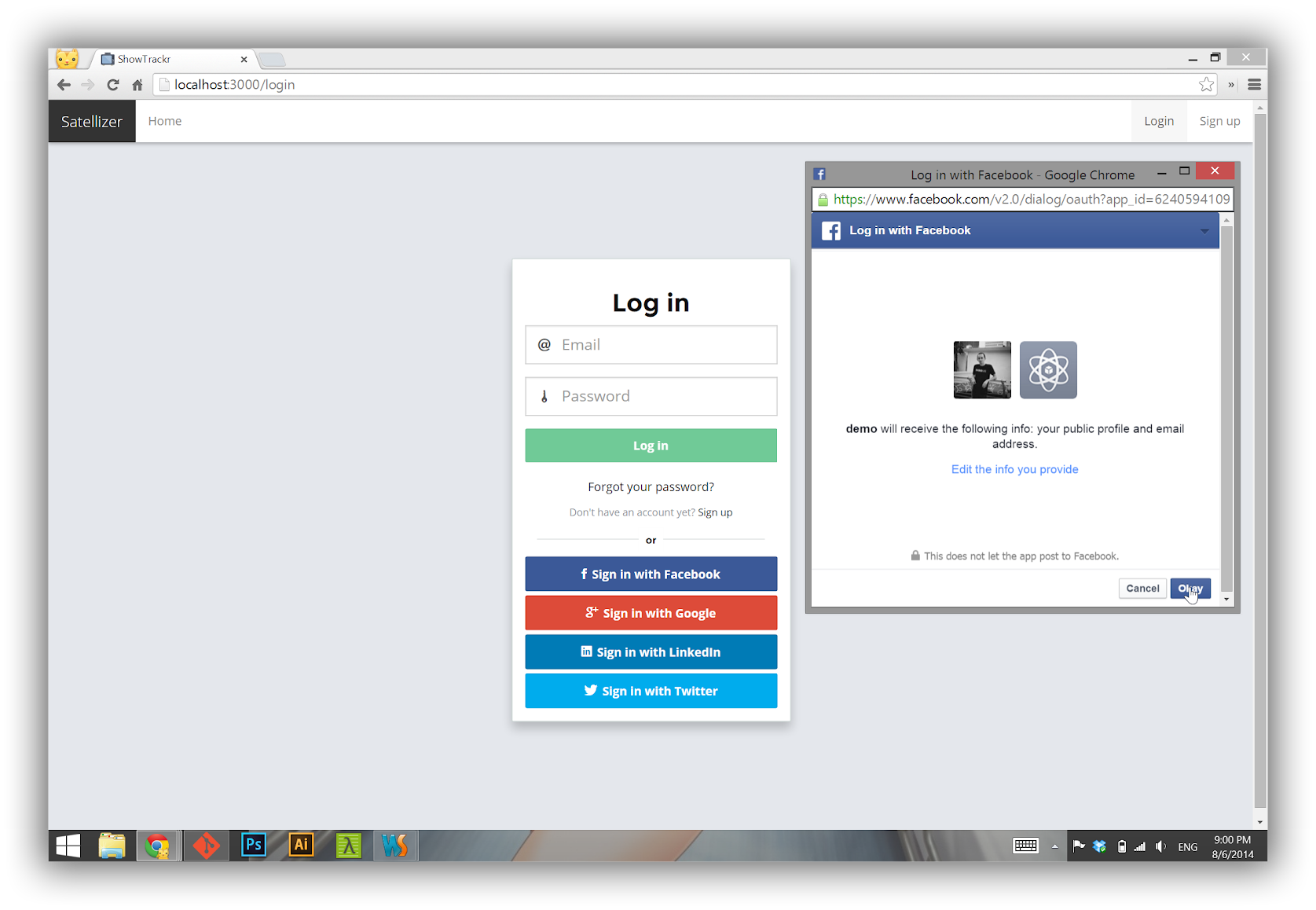Live Demo: https://satellizer.herokuapp.com
Satellizer is a simple to use, end-to-end, token-based authentication module for AngularJS with built-in support for Google, Facebook, LinkedIn, Twitter, Yahoo, Windows Live authentication providers, as well as Email and Password sign-in. You are not limited to the sign-in options above, in fact you can add any OAuth 1.0 or OAuth 2.0 provider by passing provider-specific information during the configuration step.
- Installation
- Usage
- Configuration
- Browser Support
- How It Works
- Obtaining OAuth Keys
- API Reference
- Contributing
- License
The easiest way to get Satellizer is by running one of the following commands:
# Bower
bower install satellizer
# NPM
npm install satellizerNote: Alternatively, you may download the latest release or use the CDN:
<script src="//cdn.jsdelivr.net/satellizer/0.9.2/satellizer.min.js"></script>Step 1. App Module
angular.module('MyApp', ['satellizer'])
.config(function($authProvider) {
$authProvider.facebook({
clientId: '624059410963642'
});
$authProvider.google({
clientId: '631036554609-v5hm2amv4pvico3asfi97f54sc51ji4o.apps.googleusercontent.com'
});
$authProvider.github({
clientId: '0ba2600b1dbdb756688b'
});
$authProvider.linkedin({
clientId: '77cw786yignpzj'
});
$authProvider.yahoo({
clientId: 'dj0yJmk9dkNGM0RTOHpOM0ZsJmQ9WVdrOVlVTm9hVk0wTkRRbWNHbzlNQS0tJnM9Y29uc3VtZXJzZWNyZXQmeD0wMA--'
});
$authProvider.live({
clientId: '000000004C12E68D'
});
$authProvider.twitter({
url: '/auth/twitter'
});
$authProvider.oauth2({
name: 'foursquare',
url: '/auth/foursquare',
redirectUri: window.location.origin,
clientId: 'MTCEJ3NGW2PNNB31WOSBFDSAD4MTHYVAZ1UKIULXZ2CVFC2K',
authorizationEndpoint: 'https://foursquare.com/oauth2/authenticate',
});
});Step 2. Controller
angular.module('MyApp')
.controller('LoginCtrl', function($scope, $auth) {
$scope.authenticate = function(provider) {
$auth.authenticate(provider);
};
});Step 3. Template
<button ng-click="authenticate('facebook')">Sign in with Facebook</button>
<button ng-click="authenticate('google')">Sign in with Google</button>
<button ng-click="authenticate('github')">Sign in with GitHub</button>
<button ng-click="authenticate('linkedin')">Sign in with LinkedIn</button>
<button ng-click="authenticate('twitter')">Sign in with Twitter</button>
<button ng-click="authenticate('foursquare')">Sign in with Foursquare</button>
<button ng-click="authenticate('yahoo')">Sign in with Yahoo</button>
<button ng-click="authenticate('live')">Sign in with Windows Live</button>Note: For server-side usage please refer to the examples directory.
Below is a complete listing of all default configuration options.
$authProvider.httpInterceptor = true; // Add Authorization header to HTTP request
$authProvider.loginOnSignup = true;
$authProvider.loginRedirect = '/';
$authProvider.logoutRedirect = '/';
$authProvider.signupRedirect = '/login';
$authProvider.loginUrl = '/auth/login';
$authProvider.signupUrl = '/auth/signup';
$authProvider.loginRoute = '/login';
$authProvider.signupRoute = '/signup';
$authProvider.tokenRoot = false; // set the token parent element if the token is not the JSON root
$authProvider.tokenName = 'token';
$authProvider.tokenPrefix = 'satellizer'; // Local Storage name prefix
$authProvider.unlinkUrl = '/auth/unlink/';
$authProvider.unlinkMethod = 'get';
$authProvider.authHeader = 'Authorization';
$authProvider.withCredentials = true; // Send POST request with credentials
// Facebook
$authProvider.facebook({
url: '/auth/facebook',
authorizationEndpoint: 'https://www.facebook.com/dialog/oauth',
redirectUri: window.location.origin || window.location.protocol + '//' + window.location.host + '/',
scope: 'email',
scopeDelimiter: ',',
requiredUrlParams: ['display', 'scope'],
display: 'popup',
type: '2.0',
popupOptions: { width: 481, height: 269 }
});
// Google
$authProvider.google({
url: '/auth/google',
authorizationEndpoint: 'https://accounts.google.com/o/oauth2/auth',
redirectUri: window.location.origin || window.location.protocol + '//' + window.location.host,
scope: ['profile', 'email'];
scopePrefix: 'openid';
scopeDelimiter: ' ',
requiredUrlParams: ['scope'],
optionalUrlParams: ['display'],
display: 'popup',
type: '2.0',
popupOptions: { width: 580, height: 400 }
});
// LinkedIn
$authProvider.linkedin({
url: '/auth/linkedin',
authorizationEndpoint: 'https://www.linkedin.com/uas/oauth2/authorization',
redirectUri: window.location.origin || window.location.protocol + '//' + window.location.host,
requiredUrlParams: ['state'],
scope: [],
scopeDelimiter: ' ',
state: 'STATE',
type: '2.0',
popupOptions: { width: 527, height: 582 }
});
// Twitter
$authProvider.twitter({
url: '/auth/twitter',
type: '1.0',
popupOptions: { width: 495, height: 645 }
});
// GitHub
$authProvider.github({
url: '/auth/github',
authorizationEndpoint: 'https://github.com/login/oauth/authorize',
redirectUri: window.location.origin || window.location.protocol + '//' + window.location.host,
scope: [],
scopeDelimiter: ' ',
type: '2.0',
popupOptions: { width: 1020, height: 618 }
});
// Windows Live
$authProvider.live({
url: '/auth/live',
authorizationEndpoint: 'https://login.live.com/oauth20_authorize.srf',
redirectUri: window.location.origin || window.location.protocol + '//' + window.location.host,
scope: ['wl.basic'],
scopeDelimiter: ' ',
requiredUrlParams: ['display', 'scope'],
display: 'popup',
type: '2.0',
popupOptions: { width: 500, height: 560 }
});
// Yahoo
$authProvider.yahoo({
url: '/auth/yahoo',
authorizationEndpoint: 'https://api.login.yahoo.com/oauth2/request_auth',
redirectUri: window.location.origin || window.location.protocol + '//' + window.location.host,
scope: [],
scopeDelimiter: ',',
type: '2.0',
popupOptions: { width: 559, height: 519 }
});
// OAuth 2.0
$authProvider.oauth2({
url: null,
name: null,
scope: null,
scopeDelimiter: null,
clientId: null,
redirectUri: null,
popupOptions: null,
authorizationEndpoint: null,
responseParams: null,
requiredUrlParams: null,
optionalUrlParams: null,
defaultUrlParams: ['response_type', 'client_id', 'redirect_uri'],
responseType: 'code'
});
// OAuth 1.0
$authProvider.oauth1({
url: null,
name: null,
popupOptions: null
});Note: If for some reason you are unable to send a token to
your server in the following format - Authorization: Bearer <token>, then use
$authProvider.authHeader method to override this behavior, e.g. set its value to
x-access-token or another custom header that your backend may require.
</tr>
<tr>
<td align="center">9+</td>
<td align="center">✓</td>
<td align="center">✓</td>
<td align="center">✓</td>
<td align="center">✓</td>
</tr>
Note: If you stumble upon a browser version that does not work with Satellizer please open an issue so I could update the checkmark with the lowest supported version.
Satellizer relies on token-based authentication using JSON Web Tokens instead of cookies. Each Wiki link below goes in-depth into how the authentication process works.
Note: To learn more about JSON Web Token (JWT) visit JWT.io.
- Visit [Google Cloud Console](https://cloud.google.com/console/project) - Click **CREATE PROJECT** button - Enter *Project Name*, then click **CREATE** - Then select *APIs & auth* from the sidebar and click on *Credentials* tab - Click **CREATE NEW CLIENT ID** button - **Application Type**: Web Application - **Authorized Javascript origins**: *http://localhost:3000* - **Authorized redirect URI**: *http://localhost:3000*Note: Make sure you have turned on Contacts API and Google+ API in the APIs tab.
- Visit [Facebook Developers](https://developers.facebook.com/) - Click **Apps > Create a New App** in the navigation bar - Enter *Display Name*, then choose a category, then click **Create app** - Click on *Settings* on the sidebar, then click **+ Add Platform** - Select **Website** - Enter *http://localhost:3000* for *Site URL*
- Sign in at [https://dev.twitter.com](https://dev.twitter.com/) - From the profile picture dropdown menu select **My Applications** - Click **Create a new application** - Enter your application name, website and description - For **Callback URL**: *http://127.0.0.1:3000* - Go to **Settings** tab - Under *Application Type* select **Read and Write** access - Check the box **Allow this application to be used to Sign in with Twitter** - Click **Update this Twitter's applications settings**
- Visit [Live Connect App Management](http://go.microsoft.com/fwlink/p/?LinkId=193157). - Click on **Create application** - Enter an *Application name*, then click on **I accept** button - Go to **API Settings** tab - Enter a *Redirect URL* - Click **Save** - Go to **App Settings** tab to get *Client ID* and *Client Secret*
Note: Microsoft does not consider
localhostor127.0.0.1to be a valid URL. As a workaround for local development add127.0.0.1 mylocalwebsite.netto /etc/hosts file and specifymylocalwebsite.netas your Redirect URL on API Settings tab.
$auth.login(user)$auth.signup(user)$auth.authenticate(name, [userData])$auth.logout()$auth.isAuthenticated()$auth.link(provider, [userData])$auth.unlink(provider)$auth.getToken()$auth.getPayload()$auth.setToken(token, [isLinking])$auth.removeToken()
Sign in via email and password where:
- user - Plain JavaScript object.
- response - The
$httpresponse object from the server.
$auth.login({
email: $scope.email,
password: $scope.password
});Note: This method returns a promise.
Creates a local account with email and password. You can use whatever fields you want as long as you implement them on the server.
- user - Plain JavaScript object.
- response - The
$httpresponse object from the server.
$auth.signup({
email: $scope.email,
password: $scope.password
}).then(function(response) {
console.log(response.data);
});Note: This method returns a promise.
Starts the OAuth 1.0 or the OAuth 2.0 authentication flow by opening a popup window:
- provider - One of the built-in provider names or a custom provider name created
via
$authProvider.oauth1()or$authProvider.oauth2()methods. - userData - Optional object for sending additional data to the server along with
code,clientId,redirectUri(OAuth 2.0) oroauth_token,oauth_verifier(OAuth 1.0).
- response - The
$httpresponse object from the server.
$auth.authenticate('google').then(function(response) {
// Signed In.
});Note: This method returns a promise.
Deletes a JWT from Local Storage.
$auth.logout();Note: This method returns a promise.
Returns true if a JWT is present in Local Storage and it is not expired, otherwise returns false.
Note: This method expects the exp claim to check for the expiration time.
// Controller
$scope.isAuthenticated = function() {
return $auth.isAuthenticated();
};<!-- Template -->
<ul class="nav navbar-nav pull-right" ng-if="!isAuthenticated()">
<li><a href="/#/login">Login</a></li>
<li><a href="/#/signup">Sign up</a></li>
</ul>
<ul class="nav navbar-nav pull-right" ng-if="isAuthenticated()">
<li><a href="/#/logout">Logout</a></li>
</ul>Links an OAuth provider with the signed-in account. It is practically the same as
$auth.authenticate() with the exception that it does not
redirect to $authProvider.loginRedirect route path.
- provider - One of the built-in provider names or a custom provider name created
via
$authProvider.oauth1()or$authProvider.oauth2()methods. - userData - Optional object for sending additional data to the server along with
code,clientId,redirectUri(OAuth 2.0) oroauth_token,oauth_verifier(OAuth 1.0).
Note: Linking accounts business logic is handled entirely on the server.
$auth.link('github');Note: This method returns a promise.
Unlinks an OAuth provider from the signed-in account. It sends a GET request to /auth/unlink/:provider.
- provider - One of the built-in provider names or a custom provider name created
via
$authProvider.oauth1()or$authProvider.oauth2()methods.
Note: You can override the default unlink path above via $authProvider.unlinkUrl configuration property.
Note: It uses GET method by default, but can be changed via $authProvider.unlinkMethod = 'post'. If you are going
to use POST, provider obviously should be an object, not a string.
$auth.unlink('github');Note: This method returns a promise.
Returns a JWT from Local Storage.
$auth.getToken();
// eyJhbGciOiJIUzI1NiIsInR5cCI6IkpXVCJ9.eyJzdWIiOjEyMzQ1Njc4OTAsIm5hbWUiOiJKb2huIERvZSJ9.kRkUHzvZMWXjgB4zkO3d6P1imkdp0ogebLuxnTCiYUUReturns a JWT Claims Set, i.e. the middle part of a JSON Web Token.
$auth.getPayload();
// { exp: 1414978281, iat: 1413765081, sub: "544457a3eb129ee822a38fdd" }Saves a JWT or an access token to Local Storage. It uses shared.setToken internally.
- token - An object that takes a JWT (
response.data[config.tokenName]) or an access token (response.access_token). - redirect - An optional boolean value that controls whether or not to redirect to
loginRedirectroute after saving a token. Defaults tofalse.
Removes a JWT from Local Storage.
- C# (ASP.NET vNext) implementation
- Elixir (Phoenix) implementation
- Go (Beego) implementation
- Java (Dropwizard) implementation
- Node.js (Express) implementation
- PHP (Laravel) implementation
- Python (Flask) implementation
- Ruby (Sinatra) implementation
- Scala (Play!) implementation
Found a typo or a bug? Send a pull request. I would especially appreciate pull requests for server-side examples since I do not have much experience with any of the languages on the TODO list.
A big thanks goes to Alice Chen for all your hard work on the Dropwizard implementation and Jesús Rodríguez for being so proactive and actively reporting bugs.
Additionally, I would like to thank all other contributors who have submitted issues and/or pull requests!
Satellizer was inspired by ng-token-auth and torii and angular-oauth.
The MIT License (MIT)
Copyright (c) 2015 Sahat Yalkabov
Permission is hereby granted, free of charge, to any person obtaining a copy of this software and associated documentation files (the "Software"), to deal in the Software without restriction, including without limitation the rights to use, copy, modify, merge, publish, distribute, sublicense, and/or sell copies of the Software, and to permit persons to whom the Software is furnished to do so, subject to the following conditions:
The above copyright notice and this permission notice shall be included in all copies or substantial portions of the Software.
THE SOFTWARE IS PROVIDED "AS IS", WITHOUT WARRANTY OF ANY KIND, EXPRESS OR IMPLIED, INCLUDING BUT NOT LIMITED TO THE WARRANTIES OF MERCHANTABILITY, FITNESS FOR A PARTICULAR PURPOSE AND NONINFRINGEMENT. IN NO EVENT SHALL THE AUTHORS OR COPYRIGHT HOLDERS BE LIABLE FOR ANY CLAIM, DAMAGES OR OTHER LIABILITY, WHETHER IN AN ACTION OF CONTRACT, TORT OR OTHERWISE, ARISING FROM, OUT OF OR IN CONNECTION WITH THE SOFTWARE OR THE USE OR OTHER DEALINGS IN THE SOFTWARE.









